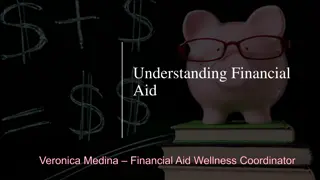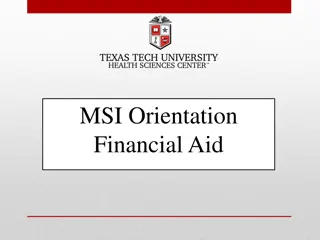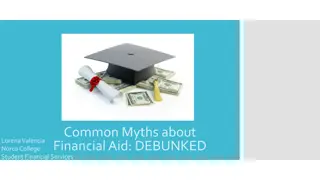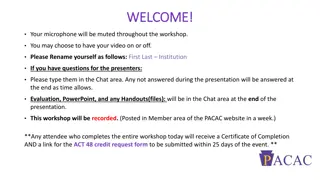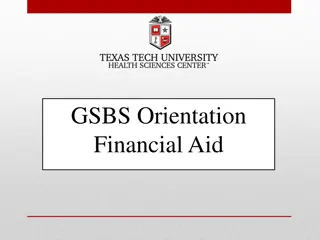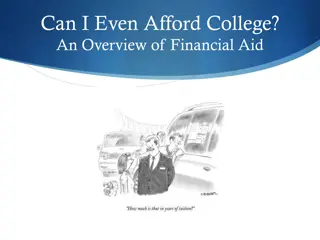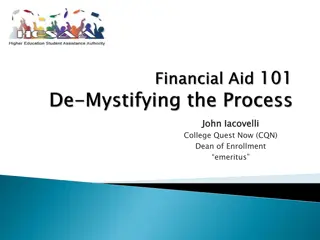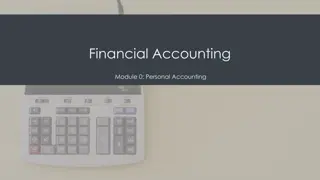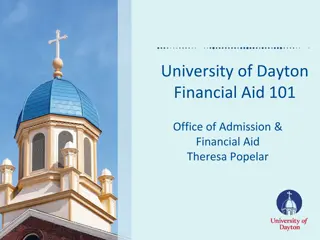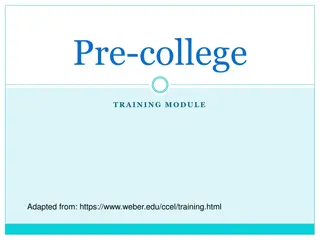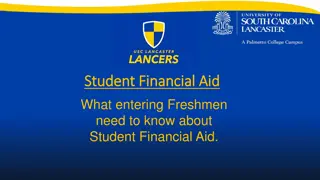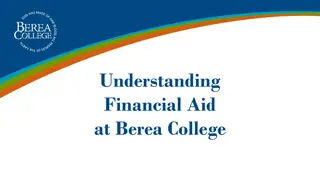Understanding Financial Aid for College
Learn about the cost of attendance, applying for financial aid through FAFSA, estimating family contribution, and examples of aid eligibility based on cost of attendance and EFC. Discover important information on planning for college expenses and maximizing available aid resources.
Download Presentation

Please find below an Image/Link to download the presentation.
The content on the website is provided AS IS for your information and personal use only. It may not be sold, licensed, or shared on other websites without obtaining consent from the author. Download presentation by click this link. If you encounter any issues during the download, it is possible that the publisher has removed the file from their server.
E N D
Presentation Transcript
Financial Aid Night Rachel Richards Shippensburg University
COST OF ATTENDANCE Each school has a different Cost of Attendance Direct Costs Tuition and Fees Average Room and Board Indirect Costs Books and Supplies Transportation Costs Personal Expenses
COST OF ATTENDANCE Examples: HACC off campus, full time: $19,348 SHIP off campus, full time: $23,622 The COA is what you should PLAN for, not what you will actually pay to a university
Free Application for Federal Student Aid FAFSA FSA User ID and Password required NEW!!! BOTH student AND parent need FSA User ID and password Each email is applicant specific Free to file Do not pay a company or individual to file Qualifies for Federal and State aid Everyone can get a low interest student loan File by May 1stfor PA State Grant
FAFSA Be diligent with data entry Social Security Number, Date of Birth, Name Email information Both parent and student Based on income, assets and household size Amount in retirement accounts DO NOT count as an asset Can file with estimated data Estimated aid is based on best estimate of income
FAFSA Estimated Family Contribution EFC Estimated or expected family contribution Numeral qualifier to determine aid eligibility Cost of Attendance minus EFC determines need If EFC is higher than COA, student is considered no need
Examples COA is $20,000; EFC is 0 = Child has a need for $20,000 in aid This student would qualify for federal PELL grant, state funding, institutional funds and Subsidized/Unsubsidized student loans COA is $20,000; EFC is 8,000 = Child has a need for $12,000 in aid This student would qualify for state funding, institutional funds and Subsidized/Unsubsidized student loans COA is $20,000; EFC is 25,000 = Child has NO NEED This student would qualify for only a Unsubsidized loan
Types of Aid Need based Federal PELL grant Federal Supplemental Educational Opportunity Grant (FSEOG) PHEAA State Grant Federal Work Study Positions Subsidized Student Loans No interest while student is attending Non-need based Unsubsidized Student Loans Interest accrues for life of the loan from first disbursement
Sources of Aid Federal Government FAFSA State Government FAFSA and PHEAA application Private Sources Civic Organizations and Churches Boys and Girl Scouts of America Elks, Moose Clubs Employers
Types of Aid Scholarships Money that does not have to be paid back Awarded based on merit, skill or unique characteristic Although student may meet criteria, still may not receive award due to funding limitations Grants Money that does not have to be paid back Usually awarded based on financial need Loans Students and parents may borrow Repayment normally begins after graduation Only borrow what is needed Look at loans as investment into the future Employment Work while attending college to assist with expenses
Needy Student Example Zero EFC full need, filed by May 1stfor State Grant Tuition, fees, room and meal plan = $23,000 billable Full PELL grant, full PA State Grant, full federal loans = $15,000 Student will still have a gap of $8000 for the year
Filing the FAFSA Who to file with Biological or adopted parents ONLY You file with the parent with whom you live If you live with mom and dad , you file with both incomes If you live with mom and she s remarried to stepfather, you file with both mom and stepdad s income If you live with dad and he s single, you file with only dad s income EFC is determined based on Income and Household Size A single mother with 1 child making $100,000 a year will have higher EFC than a married couple with three children making the same income
Filing the FAFSA If you do not live with a biological or adopted parent Please call the Financial Aid office Please speak to your high school guidance office Please see me after presentation
Filing the FAFSA 16/17 FAFSA available January 1st, 2016 Will be qualified based on 2015 income 17/18 FAFSA available October 1st, 2016 Will be qualified based on 2015 income File early, correct later Do not wait until taxes are done in April Use your last paystub from working, your W-2(s) or your 2014 taxes if they will be about the same as 2015 Use estimated data to get the FAFSA filed After taxes are completed and processed by the IRS, you can correct the FAFSA and link the tax data directly from the IRS website into the proper fields on the FAFSA
Filing the FAFSA Can add up to 10 different school codes As you are accepted to each University, they can award you an aid package if they have your FAFSA
PHEAA Application Upon completion of the FAFSA, you will be prompted to complete the State Grant Application
PHEAA State Grant Complete the questions on each page of the PHEAA site MUST PRINT THE FORM AT THE END Both student and parent must sign and MAIL back to PHEAA If you do this in year one and the FAFSA continues to be filed with same parent each year, you will not need to complete the state grant form again FAFSA must be filed no later than May 1steach year
Verification of FAFSA Federal government randomly flags records for further review called VERIFICATION Each school has individual process Must comply with verification at each school for aid to be processed Most will ask for household verification and taxes Taxes must now come DIRECTLY from IRS cannot submit your 1040 The IRS link on the FAFSA alleviates need for paper tax returns PHEAA randomly flags records for further review called INCOME VALIDATION PHEAA will email the student, the parent and will mail a letter to the home address that was listed on the FAFSA to request paperwork
FAFSA Funding Federal Grant PELL Grant Free money from the federal government to assist the most impoverished of students Maximum EFC for 15/16 award year 5198 Maximum PELL grant award for zero EFC = $5775
FAFSA Funding State Grant PHEAA State Grant Must be PA resident, attending any accredited college in PA Must graduate from PA Accredited High School Determined by PA State FAFSA must be filed by May 1st; SG application mailed EFC of 10,000 or less Maximum award for 15/16 - $3692
FAFSA Funding Institutional Aid Money allotted to each school by federal government once funding is depleted, it s gone Federal Work Study Working on campus for a paycheck Does not assist with the bill (at SHIP) FSEOG Federal Supplemental Educational Opportunity Grant Normally given to needy students, PELL eligible Maximum award for 15/16 at SHIP - $500 Perkins Loans Funding was not renewed by Federal Government for future awards
FAFSA Funding Student Loans Subsidized Student Loans (Stafford) Funded by US Department of Education Based on need Accrues NO INTEREST while in school Payment plan begins 6 months after graduation (or dropping below half time or not returning)
FAFSA Funding Student Loans Unsubsidized Student Loans (Stafford) Funded by US Department of Education Not based on need any student can receive Interest accrues for life of loan from first disbursement Current interest rate: 4.29% Payment plan begins 6 months after graduation (or dropping below half time or not returning) Both loans have a 1.068% origination fee taken prior to the loan being paid to the University
More Funding Options Parent PLUS Loans (Must file FAFSA) Loan PARENT can take out on behalf of student Based on parent s credit Solely in parent s name, can never be put in student s Can apply after April 15thonline If approved, can cover whatever amount is needed Repayment can begin while student is in school, upon graduation or 6 months after graduation Interest rate is currently 6.84% Loan has 4.272% origination fee taken prior to being paid to the University
More Funding Options Alternative Student Loans (Credit Based, Educational Loans) Normally in student s name (as long as 18) Normally require a credit worthy co-signer Interest rates can be variable Origination Fees Private bank, credit union, list of lenders on website
FAFSA Funding - Academics Qualifying for federal or state aid is based on satisfactory academic progress Federal Aid Grants, FWS, Student Loans, Parent Loans 2.0 Cumulative GPA 67% pace completion Must complete 67% of classes attempted PHEAA 24 NEW credits each year
FAFSA Funding - Academics Annual Federal Loan Limits 1styear, Freshman (less than 30 credits) = $5500 2ndyear, Sophomore (30 59 credits) = $6500 3rdyear, Junior (60 89 credits) = $7500 4thyear, Senior (90+ credits) = $7500
Reality If your child excels academically, they may get academic scholarships If your child excels athletically, they may get athletic scholarships If your income and household size shows a need , they may get free money in the form of grants No child, regardless of race, creed or nationality gets a free ride for that reason If you are a middle income family making about $110,000 or more, you will most likely be funding the education with payments and loans
What to do RIGHT NOW!!! APPLY FOR SCHOLARSHIPS!!! Check with your guidance office Your local community Your employer Parent s and grandparent s employers Online resources PHEAA www.aessuccess.org FASTWEB www.fastweb.com
Things to look out for Net Price Each school has Net Price Calculator on website Determines the amount you will have to come up with to go to that university
Example School A: Private, out of state University Tuition and Fees cost $40,000 a year University awards child $20,000 scholarship Net price = $20,000 School B: Public, in state University (like SHIP ) Tuition and fees cost $10,000 a year University awards child $2,000 scholarship Net price = $8,000
Things to look out for Don t pay for free money If it s too good to be a true, it normally is Buyer beware Social Security Numbers Scams
Reminders!! File early Check often TEAM EFFORT
QUESTIONS???? Rachel Richards Associate Director of Financial Aid Shippensburg University 717-477-1123 ext. 3012 717-477-1131 rdrichards@ship.edu finaid@ship.edu






